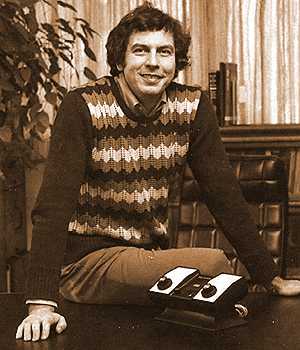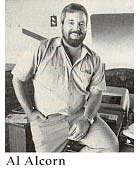
HISTORY OF HOME AND GAME COMPUTERS

| Navigator | ||||||||||||||||||
|
|
|
|
||||||||||||||||
|
|
||||||||||||||||||
Welcome to the nostalgic
history of home and game computers
ATARI'S PONG - CONQUEST OF THE LIVING ROOMS
(This is Part 2 about Atari's Pong - click
here
for Part 1)
It was also due to Atari that in the seventies millions of people 'lost' billions of hours with playing tennis on television screen. Everybody who played the game still remembers the typical sounds when scoring and when hitting with the paddle.
 Competition
Competition
One
of the reasons Atari started with a home version of Pong, was the tremendous
competition it experienced on Pong in the arcades. Dozens of competitors had
imitated Pong and other arcade games of Atari, the result being that Atari found
itself on the edge of bankruptcy.
The idea for a home version of Pong came from Atari engineers Bob Brown and
Harold Lee. Nolan Bushnell reacted enthusiastically and told them to go ahead,
in spite of the scepticism of the other Atari-managers. They had doubts about
the idea because Atari until then had zero experience in the consumer industry.
Distribution, marketing in this line of business - it was 'terra incognito' and
could even bring Atari in much greater financial trouble.
Code name 'Darlene'
But 'Home Pong' eventually would solve the financial
problems. The idea was to concentrate all electronic components of Al Alcorn's
arcade version into one chip. It was a revolutionary plan, but Lee was convinced
it could be realized. The team worked hard and again family members were engaged.
Harold Lee designed the logical schemes, which were wire-wrapped at home in the
evenings by Alcorn's wife. Alcorn on his turn had the nice task to debug the
schemes and to return the corrected designs to Lee.
Thus after some time arose a working prototype of Pong, which provisionally
carried the code name 'Darlene', after an attractive female co-worker. And thus
a tradition was born to name projects after Atari-women.
Plump
Darlene was at the least a bit plump: the
prototype was filled with hundreds of wires. In the fall of 1974 the prototype
of the chip was ready, which would replace Darlene's belly.
According to today's standards it's extremely simple: a tennis game on a television screen. But in 1974, the chip needed was the most sophisticated ever used in a consumer product.
Secret rooms
Now Atari was in a hurry to find toy chains wanting to sell
Pong. That appeared to be far from easy: the toy business had the failure of the
Magnavox Odyssey (only 100,000 consoles sold) fresh in memory. The toy chains
estimated that consumers didn't want television games. Besides that, they found
the price of 100 dollar far too high.
Further efforts followed on the 1975 Toy Show in New York, a fair for the toy industry. Atari ran a booth on the Toy Show and even pulled much attention with Pong. Many interested buyers showed up, but at the end of the fair Atari had not a single unit sold. The inexperience of the newcomer in the toy line revenged itself. According one of those unwritten rules in the toy industry, contracts weren't closed on the floor but in private suites arranged by the manufacturers. And Atari didn't have a private room - it had never heard about it.
|
Jumping out the window Exclusive rights Don Valentine |
Hilaric moments The cause of this appeared to be an antenna on the roof of the Sears building that broadcasted a signal on channel 3 - the channel which was also used by Pong, so the signal Pong sent to the TV was interfered by the broadcasting signal. Sweating and sweating, Alcorn dived in the mass of wires (demonstrated was the prototype without chip); a painful moment about which Alcorn said later he was ready to jump out the window. But he succeeded to have Pong function on channel 4, which wasn't disturbed by interference. (Is it because of this event that many pong consoles later had a switch for channel 3 or 4?) Although the rest of the
demonstration went ahead without problems, there was still one big concern
in the Sears audience: the enormous amount of wires in the device. When
Alcorn explained that all those wires would be replaced by a silicon chip
the head of the department reacted sceptically. He asked how Alcorn would
manage to solder the wires to the chip...
|
Waiting hours in line
Christmas 1975, Pong was the smashing hit
for Sears. In several towns people had to wait hours in line for the shops, not
to buy Pong, but to put their name on a list to order it. Pong was sold in 900
shops through the U.S., as a result of which the name Atari wasn't only known by
arcade players, but by a broad public too. Thanks to Pong, Atari in 1975 had a
turnover of 40 million dollar, of which 3 million profits.
 Compared to the Odyssey The home version of Pong was mainly based on the arcade version. It contained only one game: tennis. Unlike consoles that appeared later, the controllers couldn't be separated from the device. A revolutionary phenomenon was that Pong displayed the score on the screen. Players on the analogue Magnavox Odyssey had to write the score down or remember it. Also unlike the Odyssey, where the controllers contained an extra button to add spin to the ball, Pong automatically added spin. The amount of spinning depended on the segment of the paddle that hit the ball - like the arcade model each paddle contained eight segments. |
Pong chip Own Pong
version
|
| News | |||
|
|
|
|
|
|
|
|||
View results from last poll:how many games you have? (3127 votes)
 This
lead to some hilaric moments. Biggest problem was that Alcorn didn't
succeed to get the pong graphics normally displayed at the television
screen.
This
lead to some hilaric moments. Biggest problem was that Alcorn didn't
succeed to get the pong graphics normally displayed at the television
screen.
